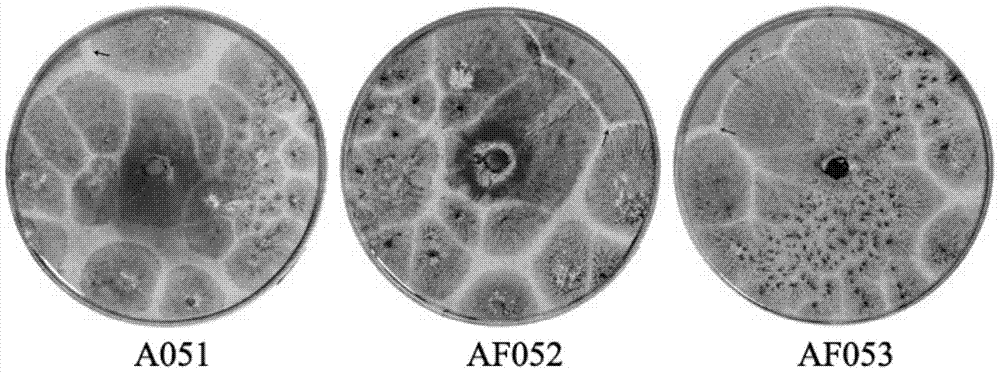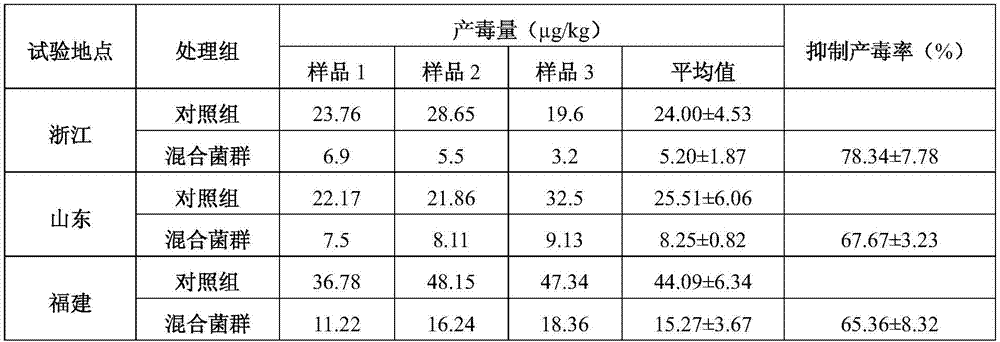Aspergillus flavus strains and mixed flora that do not produce aflatoxin and their application
A kind of technology of aflatoxin and Aspergillus flavus strains, applied in the direction of application, fungi, and methods based on microorganisms, etc., can solve the problems of unstable control effect, reduce unstable control effect, expand the scope of applicable regions, and improve utilization rate Effect
- Summary
- Abstract
- Description
- Claims
- Application Information
AI Technical Summary
Problems solved by technology
Method used
Image
Examples
Embodiment 1
[0031] Embodiment 1 does not produce the isolation of the aspergillus flavus strain of aflatoxin, identification
[0032] 1. Isolation of Aspergillus flavus strains from soil, corn, peanut and other habitats
[0033] Soil was collected from corn and peanut fields in Jiangsu, Zhejiang, Shandong, Fujian, Anhui and other places, and the soil was cultured with YES medium to isolate Aspergillus flavus strains. Ingredients per liter of YES medium: Yeast extract 1g, sucrose 10g, NaCl 60g, agar 20g, add CuSO after sterilization 4 .ZnSO 4 1 mL, 0.4% clonamide 5 ml, streptomycin 100 μg / mL.
[0034] 2. Use bioassay, thin-layer chromatography and enzyme-linked immunoassay to analyze the aflatoxin production of the strain.
[0035] details as follows:
[0036] Bioassay method: Inoculate the isolated Aspergillus flavus strain on YES medium containing 0.3% cyclodextrin, culture it at 30°C for 7 days, fumigate the colony with 25% ammonia water for 3 minutes, if the back of the colony is pin...
Embodiment 2
[0053] Identification of aflatoxin synthetic gene deletion in the aspergillus flavus strains A 051, A F 052 and A F 053 that do not produce aflatoxin in embodiment 2
[0054] (1) Primer synthesis
[0055] In order to clarify the deletion of the aflatoxin synthesis gene in the non-aflatoxin-producing Aspergillus flavus strains A051, AF052 and AF053, the test refers to the literature Perng-Kuang Chang (ChangP.K., Horn, B.W.and Dorner, J.W. (2005) Sequence Breakpoints in the aflatoxin biosynthesis gene cluster and flanking regions in nonaflatoxigenic Aspergillus flavus isolates. Fungal GenetBio 42, 914-923.) Design primers for the identification of toxin synthesis genes, and identify the deletion of related genes in strains A051, AF052 and AF053 .
[0056] (2) Gene deletion identification
[0057] Using the extracted DNA of Aspergillus flavus strains A051, AF052 and AF053 as templates, conventional PCR reactions were carried out with the above primers, and each reaction had a D...
Embodiment 3
[0061] Example 3 Indoor test evaluation of the inhibitory effect of the Aspergillus flavus biocontrol strain group that does not produce aflatoxin on the Aspergillus flavus producing aflatoxin on corn
[0062] (1) Preparation of corn
[0063] Weigh 20 g of corn, crush it with a juice extractor, and sterilize at 121° C. for 30 minutes before use.
[0064] (2) Preparation and cultivation of bacterial suspension
[0065] The non-toxin-producing Aspergillus flavus strains A051, AF052, AF053 and the aflatoxin-producing Aspergillus flavus standard strain NRRL3357 were respectively inoculated on PDA medium (200 g of potatoes, 20 g of glucose, 20 g of agar, and adding water to 1 L), and the plate was placed at 30 After culturing at ℃ for 5 days, add 0.1% Tween 20 to wash and collect spores, use a vortex shaker to shake and mix, and then adjust the spore concentration with a hemocytometer. A total of 5 treatments were set up in the experiment, as follows:
[0066]Treatment 1: The sp...
PUM
| Property | Measurement | Unit |
|---|---|---|
| diameter | aaaaa | aaaaa |
Abstract
Description
Claims
Application Information
 Login to View More
Login to View More - R&D
- Intellectual Property
- Life Sciences
- Materials
- Tech Scout
- Unparalleled Data Quality
- Higher Quality Content
- 60% Fewer Hallucinations
Browse by: Latest US Patents, China's latest patents, Technical Efficacy Thesaurus, Application Domain, Technology Topic, Popular Technical Reports.
© 2025 PatSnap. All rights reserved.Legal|Privacy policy|Modern Slavery Act Transparency Statement|Sitemap|About US| Contact US: help@patsnap.com



